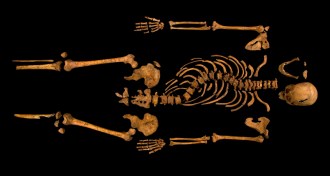Archaeology
-
 Archaeology
ArchaeologyA king’s final hours, told by his mortal remains
The skeleton of Richard III reveals a violent and chaotic end for a controversial English monarch.
-
 Humans
HumansPots bear oldest signs of cheese making
Some of Europe’s first farmers created perforated vessels to separate curds from whey.
By Bruce Bower -
 Earth
EarthMexican silver made it into English coins
Chemical tests of currency help reveal where New World riches flowed.
-
 Humans
HumansOldest examples of hunting weapon uncovered in South Africa
A common ancestor of people and Neandertals may have flung stone-tipped shafts at animal prey.
By Bruce Bower -
 Humans
HumansAn ancient civilization’s wet ascent, dry demise
Cave data suggest that ancient rainfall patterns swayed the course of Classic Maya societies.
By Bruce Bower -
 Humans
HumansAncient blades served as early weapons
African find reveals complex toolmaking 71,000 years ago.
By Erin Wayman -
 Humans
HumansFeather finds hint at Neandertal art
Plumage found at ancient sites may indicate capability for abstract thought among humans’ Stone Age cousins.
By Bruce Bower -

-
 Humans
HumansHerders, not farmers, built Stonehenge
Farming’s temporary demise in ancient Britain may have spurred the creation of the iconic stone circle.
By Bruce Bower -
 Humans
HumansGood times led to grisly custom
Ancient Chileans developed artificial mummification after an increase in the numbers of living and dead people made naturally preserved bodies hard to ignore.
By Bruce Bower -
 Anthropology
AnthropologySticks, stones and bones reveal emergence of a hunter-gatherer culture
A cave in southern Africa was occupied by people very much like those living in the region today.
By Meghan Rosen -
 Humans
HumansApocalypse, not so fast
Guatemalan find suggests mention of a date far in the future served a Maya king’s immediate needs.
By Bruce Bower